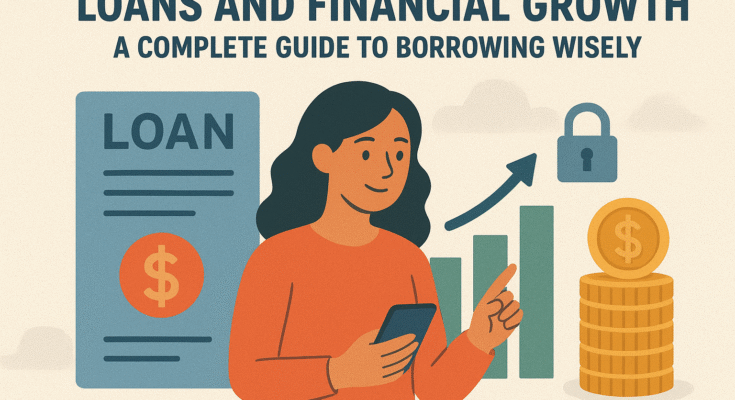Loans are a cornerstone of modern finance. They bridge the gap between what people can afford today and what they aspire to achieve in the future. For many, loans provide access to life’s biggest milestones—purchasing a home, paying for education, starting a business, or buying a car. They also serve as safety nets in times of emergencies.
While loans make it possible to accomplish goals faster, they must be managed carefully. Borrowing without a plan can create long-term financial stress. But when approached strategically, loans are not just about debt—they are tools that can help build wealth, stability, and opportunity.
This guide explores how loans work, the different types available, the risks and rewards of borrowing, and the best ways to use loans as part of a strong financial strategy.
The Role of Loans in Financial Life
Borrowing money is not just about covering expenses. It is a way to unlock opportunities. Few people can afford to buy a house with cash, yet homeownership becomes achievable with a mortgage. Education, which often requires thousands in tuition fees, becomes accessible with student loans. Entrepreneurs can expand their businesses through borrowed capital.
Loans make it possible to enjoy the benefits of assets today while paying for them gradually. Instead of waiting decades to save enough for a house, borrowers can live in and build equity in a home while they repay the loan. This ability to spread costs across time turns large goals into manageable steps.
However, loans are double-edged. Borrowing for essential investments can accelerate growth, but taking loans for short-term pleasures or luxury items can create financial strain. The difference lies in using debt strategically—choosing loans that add long-term value rather than short-lived satisfaction.
Different Types of Loans
The lending industry offers a wide range of products. Each serves a specific purpose, and understanding these categories helps borrowers choose wisely.
Personal Loans
Personal loans are flexible and can be used for many purposes, such as consolidating debt, covering medical expenses, or making large purchases. They are usually unsecured, meaning they do not require collateral. Because of this, interest rates depend heavily on credit scores and income stability.
Mortgages
Mortgages are among the most common loans. They allow individuals to purchase homes and repay the amount over long periods, usually 15 to 30 years. Mortgages are secured loans, with the property itself serving as collateral. Interest rates tend to be lower than unsecured loans, but the total repayment amount can be significant due to the long term.
Auto Loans
Auto loans make vehicle ownership more accessible. Like mortgages, they are secured loans, with the car serving as collateral. Repayment periods are shorter, often three to seven years. Interest rates vary depending on credit history, the type of car, and whether the loan is new or used.
Student Loans
Education is one of the biggest investments a person can make. Student loans are designed to cover tuition, books, and living expenses. While they can lead to heavy debt, they are often considered worthwhile because higher education typically increases long-term earning potential.
Business Loans
Business loans provide entrepreneurs with funds to expand operations, purchase equipment, or cover operating expenses. They can be secured or unsecured, with terms depending on the size of the loan and the financial health of the business. Properly managed, these loans fuel growth and create jobs.
Lines of Credit
Lines of credit function differently from fixed-term loans. Instead of receiving a lump sum, borrowers access funds as needed up to a certain limit. Interest is paid only on the amount borrowed, making lines of credit flexible for managing cash flow.
Payday and Short-Term Loans
These loans offer quick access to money but often come with very high interest rates and fees. They are usually meant to cover immediate expenses until the next paycheck. However, because of their high cost, they can trap borrowers in cycles of debt if not repaid quickly.
Understanding Interest Rates
Interest rates are at the heart of every loan. They determine how much borrowing costs over time. Even small differences in rates can add up to thousands of dollars across the life of a loan.
Fixed vs. Variable Rates
Fixed interest rates remain the same throughout the loan, making payments predictable. Variable rates fluctuate with market conditions, which means they can save money when rates are low but increase costs if rates rise.
The Role of Credit Scores
A borrower’s credit score is one of the biggest factors influencing interest rates. Lenders view higher scores as a sign of reliability, which translates to lower borrowing costs. On the other hand, poor credit often leads to higher rates or loan denials.
Market Conditions
Broader economic factors, such as central bank policies and inflation, also affect interest rates. Understanding these trends helps borrowers decide the right time to apply for a loan.
Benefits of Borrowing
When managed wisely, loans can bring significant advantages.
- Access to Opportunities: Loans make it possible to achieve goals sooner, whether that means owning property, pursuing education, or expanding a business.
- Building Credit: Responsible borrowing and repayment strengthen credit scores, which opens doors to better financial products in the future.
- Leveraging Growth: Loans allow individuals and businesses to invest in opportunities that can generate returns greater than the cost of borrowing.
- Flexibility: Different loan types cater to different needs, offering solutions for both short-term expenses and long-term investments.
Risks of Borrowing
While loans are valuable tools, they carry risks that must be considered carefully.
- Debt Burden: Taking on too much debt can lead to financial stress and limit future opportunities.
- High Interest Costs: Loans with high rates, especially payday loans or credit card debt, can quickly grow unmanageable.
- Collateral Risk: Secured loans put assets like homes or cars at risk if repayments are missed.
- Emotional Stress: Debt can cause anxiety, strain relationships, and reduce financial confidence.
The key is balancing the benefits with potential drawbacks and borrowing only when repayment is realistic.
Mistakes to Avoid When Taking Loans
Many borrowers fall into common traps that make repayment harder. Avoiding these mistakes can save years of financial stress.
- Borrowing Without a Plan: Taking a loan without clear repayment strategies often leads to missed payments and growing debt.
- Ignoring the Fine Print: Hidden fees, penalties, or variable rate clauses can add unexpected costs.
- Overestimating Income: Assuming future income will grow enough to cover debt is risky. Borrowers should base decisions on current financial stability.
- Using Loans for Wants, Not Needs: Financing vacations, luxury items, or non-essential purchases with loans often results in regret.
Smart Strategies for Borrowing
Using loans wisely means treating them as part of a broader financial plan.
- Borrow Only What’s Necessary: Limiting loan amounts reduces repayment stress and interest costs.
- Compare Lenders: Different institutions offer different rates and terms. Shopping around ensures the best deal.
- Maintain Good Credit: Paying bills on time, reducing debt, and keeping credit utilization low improve borrowing terms.
- Focus on Long-Term Value: Loans should be directed toward assets or opportunities that grow in value, such as homes, education, or businesses.
- Build an Emergency Fund: Having savings reduces the chance of relying on high-interest loans during crises.
The Future of Lending
The lending industry is rapidly evolving. Digital platforms are streamlining applications, approvals, and repayments. Borrowers can now access loans without ever stepping into a bank branch.
Artificial intelligence is improving credit assessments, making lending more personalized. Blockchain technology promises faster, more transparent transactions. Peer-to-peer lending platforms are creating alternatives to traditional banks, connecting borrowers directly with investors.
This innovation benefits consumers by offering more options, lower fees, and greater convenience. However, it also requires borrowers to stay informed. Choosing the right platform, understanding terms, and protecting personal data are more important than ever.
Final Thoughts
Loans are not inherently good or bad—they are tools. Like any tool, their value depends on how they are used. Borrowing to invest in education, housing, or business growth can accelerate financial success. Borrowing for unnecessary spending, however, can limit progress for years.
The smartest approach is to view loans as part of an overall financial strategy. By understanding loan types, interest rates, risks, and repayment strategies, individuals can make informed decisions. With discipline and planning, loans can move from being a burden to becoming a stepping stone toward financial independence.
In a world where access to borrowing is easier than ever, the real advantage belongs to those who borrow with wisdom.


